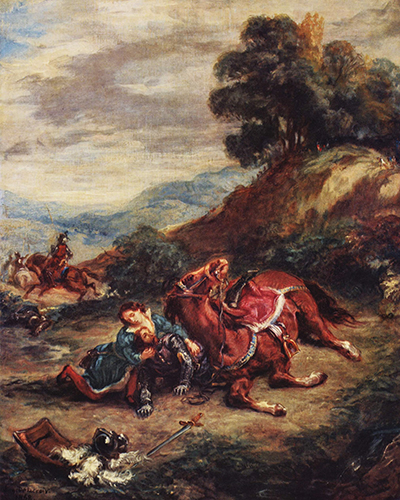This painting captures a wounded gentleman, who lies on the ground whilst being comforted by another. Some list the title of this painting instead as The Death of Lara, not Laras. The painting itself is dated at around 1858 and is very much in the Romanticist style.
The artist produced several different versions of this theme, each noticeably different from the last. Some were in watercolours and others, such as this one, were completed using oils. The tones of this piece feel very much Delacroix-esque, with reddish tones appearing in areas of detail alongside the darker greens for foliage which decorates the other parts of the composition. We find a horse lying to the side, symbolising an incident, probably causing the man's peril. Delacroix would himself include animals many times across his career and clearly felt a great fondness to them, normally picturing them as victims rather than an aggressor. It you take out the drama of this work, and just had the landscape items left, one could almost be viewing the art of another Romanticist, namely John Constable. This particular painting is 62cm in height and around 50cm in width, which is relatively small but not uncommon within this artist's career.
There is much to see within this painting, with a sprawling landscape pictured in the far distance and all manner of different objects dotted about in the foreground. The artist liked to create an atmosphere of emotion in his paintings and would also combine humanity with animals and nature in order to produce unique depictions which felt exciting and real. In the distance we can see a number of other riders which suggests that this incident was during a battle or a hunt, both of which were covered frequently elsewhere in this artist's career. He loved to use watercolours at times in his career but also felt that oils could offer a greater precision of detail and so for this artwork chose to use the latter. He also became famous for using certain tones of colour, making some of his paintings instantly recognisable, even when placed against others from the same movement.
Delacroix produced some of the most important contributions to the Romanticist movement, with highlights including the likes of Liberty Leading the People, Death of Sardanapalus and Massacre at Chios. He would specifically seek out moments in history which provided drama and emotion for his paintings and would cover many different periods in order to find these events. In some cases he also made use of literature to allow his imagination to run wild on the canvas, making use of his carefully honed technical abilities which could allow him to explore his mind without any real limit. Delacroix himself remains one of the most important French artists in history and shall never be forgotten even as tastes continue to change in future years.




